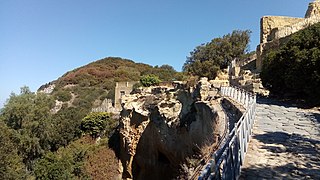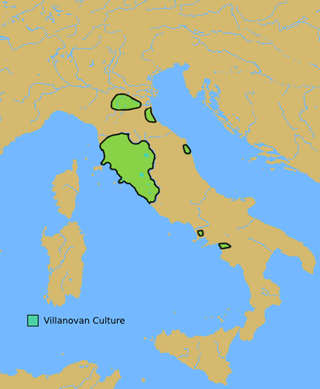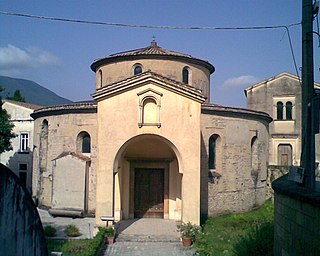
Crotone is a city and comune in Calabria, Italy.

Cumae was the first ancient Greek colony of Magna Graecia on the mainland of Italy, founded by settlers from Euboea in the 8th century BC and soon became one of the strongest colonies. It later became a rich Roman city, the remains of which lie near the modern village of Cuma, a frazione of the comune Bacoli and Pozzuoli in the Metropolitan City of Naples, Campania, Italy.

Grave goods, in archaeology and anthropology, are items buried along with a body.

Kechries is a village in the municipality of Corinth in Corinthia in Greece, part of the community of Xylokeriza. Population 238 (2011). It takes its name from the ancient port town Kenchreai or Cenchreae, which was situated at the same location.

The Archaeology Museum of Catalonia is an archaeological museum with five venues that exposes the most important archaeological collection of Catalonia, focusing on prehistoric times and ancient history. The museum was originally founded in 1932 by the Republican Government of Catalonia. The modern institution was created under the Museums of Catalonia Act in 1990 by the Ministry of Culture of the same Government.

The Villanovan culture, regarded as the earliest phase of the Etruscan civilization, was the earliest Iron Age culture of Italy. It directly followed the Bronze Age Proto-Villanovan culture which branched off from the Urnfield culture of Central Europe. The name derives from the locality of Villanova, a fraction of the municipality of Castenaso in the Metropolitan City of Bologna where, between 1853 and 1855, Giovanni Gozzadini found the remains of a necropolis, bringing to light 193 tombs, of which there were 179 cremations and 14 inhumations.

Tharros was an ancient city and former bishopric on the west coast of Sardinia, Italy.

Nocera Superiore is a town and comune in the province of Salerno in the Campania region of south-western Italy.

Pontecagnano Faiano is a town and comune of the province of Salerno in the Campania region of south-west Italy. The area dates back to Roman times when the city of Picentia stood in the place and was destroyed by the Romans after the Second Punic War.

Roccagloriosa is a town and comune in the province of Salerno in the Campania region of south-western Italy.

The Archaeological Museum of Nafplio is a museum in the town of Nafplio of the Argolis region in Greece. It has exhibits of the Neolithic, Chalcolithic, Helladic, Mycenaean, Classical, Hellenistic and Roman periods from all over southern Argolis. The museum is situated in the central square of Nafplion. It is housed in two floors of the old Venetian barracks.

Hephaestia and Hephaistia, or Hephaestias or Hephaistias (Ἡφαιστίας), was a town of Ancient Greece, now an archeological site on the northern shore of Lemnos, Greek island in the northern Aegean Sea. It was named in the honor of Hephaistos, Greek god of metallurgy, whose cult was maintained on the island. It was once the capital of the island, of which only the ruins remain.

The Archaeological Museum of Eretria is a museum in Eretria, in the Euboea regional unit of Central Greece.

Gordion was the capital city of ancient Phrygia. It was located at the site of modern Yassıhüyük, about 70–80 km (43–50 mi) southwest of Ankara, in the immediate vicinity of Polatlı district. Gordion's location at the confluence of the Sakarya and Porsuk rivers gave it a strategic location with control over fertile land. Gordion lies where the ancient road between Lydia and Assyria/Babylonia crossed the Sangarius river. Occupation at the site is attested from the Early Bronze Age continuously until the 4th century CE and again in the 13th and 14th centuries CE. The Citadel Mound at Gordion is approximately 13.5 hectares in size, and at its height habitation extended beyond this in an area approximately 100 hectares in size. Gordion is the type site of Phrygian civilization, and its well-preserved destruction level of c. 800 BCE is a chronological linchpin in the region. The long tradition of tumuli at the site is an important record of elite monumentality and burial practice during the Iron Age.

The Gaudo Culture is an Eneolithic culture from Southern Italy, primarily in the region of Campania, active at the end of the 4th millennium BC, whose typesite necropolis is located near Paestum, not far from the mouth of the river Sele. Its name comes from the Spina-Gaudo necropolis.

Galera is a municipality in the comarca of Huéscar, province of Granada, autonomous community of Andalusia, Spain. It is situated in a sparsely populated area roughly 150 kilometres (93 mi) from the provincial capital, Granada.
Part of series of articles upon Archaeology of Kosovo

Vassallaggi is a Sicilian prehistoric Bronze Age archaeological site, located on the hill of the same name, which had a later flourishing after the 7th century BC as a phrourion (fortress). The site is located in the middle of the Salso river valley, at 704 m above sea level, near San Cataldo in the province of Caltanissetta, in a strategic location for communication between the southern coast of Sicily and the northern part of the island. It has a NE-SW orientation and stretches along in parallel with the SS 122 San Cataldo-Serradifalco.

The National Archaeological Museum of the Marches is an archaeological museum in Ancona, Marches, Italy. It is located in the Palazzo Ferretti, and 13,195 people visited the collections in 2015.

The regional archaeological museum of Kamarina is in the vicinity of Scoglitti in the Libero consorzio comunale di Ragusa (Sicily) and consists of three pavilions and seven rooms exhibition.




















